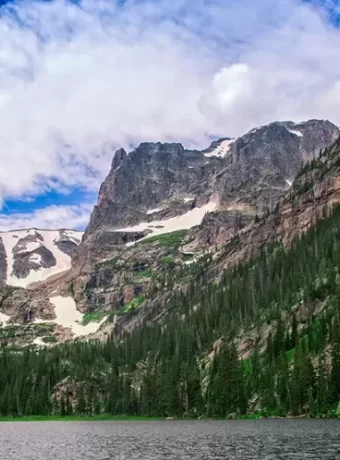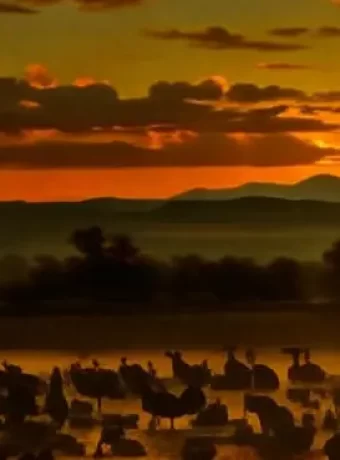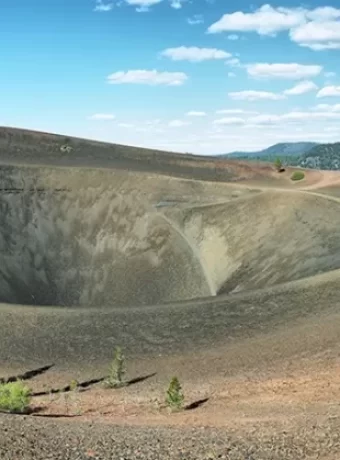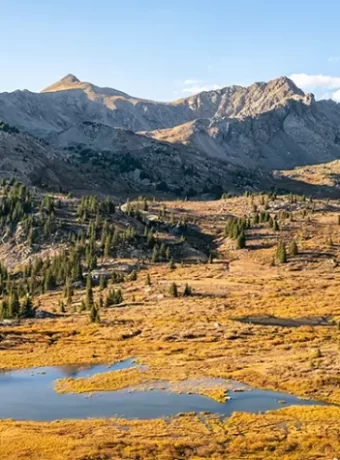Explore Wildlife Wonders at Lake Manyara National Park
Imagine a place where the wilderness meets whimsy, and nature’s nuances come alive in vibrant hues—that’s Lake Manyara National Park for you. Nestled at the base of the Great Rift Valley escarpment, this Tanzanian treasure unfolds across diverse landscapes, from its soda lake to dense woodlands and rocky slopes.
Lake Manyara National Park is more than just a visual treat; it’s an ecological wonderland. Ready to spot tree-climbing lions or gaze upon flocks of flamingos painting the horizon pink? How about mingling with majestic elephants that roam beneath baobabs?
Let’s dive into what makes this park unique—no fluff, just straight-up awe-inspiring experiences awaiting your discovery.
Table Of Contents:
- Discovering Lake Manyara National Park’s Diverse Habitats
- Birdwatching Paradise at Lake Manyara
- Encounters with Tree-Climbing Lions and Elephants
- Planning Your Safari Adventure in Lake Manyara
- Conservation Initiatives Protecting Natural Wonders
- Cultural Interactions Around Mto wa Mbu Village
- Header Comparisons with Other Tanzanian Safaris
- Unique Wilderness Experience Amidst Breathtaking Landscapes
- Hot Springs Maji Moto: A Natural Retreat
- Practical Advice for First-Time Visitors
- FAQs in Relation to Lake Manyara National Park
- Conclusion of Lake Manyara National Park
- Summit Kilimanjaro, a Safari in The Serengeti, The World’s a Playground
- Zebras in Lake Manyara National Park
- Elephant in Lake Manyara National Park
- Giraffe in Lake Manyara National Park
- Take a Safari in Lake Manyara National Park
Come climb Kilimanjaro and a Safari in Lake Manyara National Park Click Here
Discovering Lake Manyara National Park’s Diverse Habitats
Welcome to a land where the earth bubbles with alkaline waters and acacia woodlands whisper ancient tales. Nestled in Tanzania, Lake Manyara National Park is not just another dot on the map—it’s a living mosaic of diverse landscapes.
The Alkaline Soda Lake
In this park, two-thirds are submerged under an expansive soda lake—a surreal haven that paints the scenery with shades of nature you’ve never imagined. But it’s more than just looks; this alkaline wonder draws flocks of flamingos that streak pink across blue skies. As they forage among shallow waters, these iconic birds join hundreds of other bird species in what can only be described as an avian utopia.
While water levels ebb and flow with the whimsy of weather patterns, each season reveals new secrets along rocky slopes surrounding its shores—secrets avid birdwatchers travel continents to uncover.
Acacia Woodlands and Majestic Baobabs
Beyond the shimmering reflections lies dense acacia woodland—a tapestry woven from thorny branches housing life unseen but deeply felt. Within these green corridors roam large herds seeking shade beneath towering baobab trees—the grand elders whose roots dig deep into African soil, holding stories older than time itself.
This terrestrial biodiversity hotspot isn’t shy about showing off its beauty either. Here amidst steep rocky escarpments lies a rich world brimming with whispers from grey crowned cranes while mischievous monkeys leap through evergreen forests brushing shoulders with tree-climbing lions unique to this pocket of northern Tanzania.
So come explore Lake Manyara National Park’s vastness—an ecosystem vibrant yet serene, bustling yet peaceful—and find yourself lost in habitats both alien and familiar.
Birdwatching Paradise at Lake Manyara
Imagine stepping into a world where the sky dances with a kaleidoscope of colors, thanks to the bird species that call Lake Manyara National Park home. Here, amidst Tanzania’s lush landscapes, bird enthusiasts find their haven. The park is renowned for hosting thousands of flamingos along its soda shores during peak seasons—creating a sea of pink that has become an iconic spectacle in this corner of Africa.
Flamingo Spectacle on Soda Shores
The alkaline lake within Lake Manyara National Park serves as the perfect backdrop for one of nature’s most stunning performances—the gathering of countless flamingos wading through shallow waters. This breathtaking sight peaks when water levels recede and algae flourish, providing ample food for these leggy birds. Visitors often marvel at how these elegant creatures coordinate their movements across the reflective lake surface like ballet dancers clad in vibrant costumes.
This isn’t just about aesthetics; it’s also a significant ecological event worth witnessing firsthand—a testament to why Lake Manyara National Park stands out as an essential stopover for anyone passionate about ornithology or simply enchanted by natural beauty.
A Haven For Hundreds Of Bird Species
Beyond the headlining flamingos lies diversity so rich it would put any avian encyclopedia to shame. With hundreds of resident and migratory bird species finding refuge here, you could spend days peering through binoculars and still discover new wonders flying overhead or nesting among acacia trees lining flood plains—an evergreen forest that acts as both sanctuary and stage for feathered performers from grey crowned cranes to secretive pelicans hidden amongst dense foliage.
Lake Manyara doesn’t discriminate; whether they are adorned with subtle hues or boast striking patterns worthy of runway fame in Milan—if there’s such thing as fashion week among our winged friends—they’re all partaking in what can only be described as Mother Nature’s greatest airshow above northern Tanzania’s rift valley landscape.
An Ecosystem In Harmony
This national park offers more than just fleeting glimpses—it provides profound connections between lifeforms thriving within interconnected habitats shaped by geological forces over millennia. It exemplifies conservation success stories: ecosystems maintained not only through preservation but also via respectful human interaction from nearby communities contributing cultural richness equaling its biological counterpart around Mto wa Mbu village peripheries.
This equilibrium not only captivates guests with a sense of wonder but also instills a profound respect for these winged marvels. It’s an engagement that goes beyond seeing—it’s about connecting on a level that transcends the visual, creating lasting impressions in the hearts and minds of those who journey here. Ensuring this sanctuary remains untouched allows for the promise of similar awe-inspiring experiences to be passed down, as each visitor becomes part of Selous’ enduring legacy under the expansive African firmament.
Step into Lake Manyara National Park to witness a birdwatching haven where thousands of flamingos paint the shores pink and hundreds of bird species thrive in harmony, offering an awe-inspiring spectacle amidst Tanzania’s lush landscapes.
Encounters with Tree-Climbing Lions and Elephants
Tanzania is a land of marvels, and Lake Manyara National Park stands out with its headline act: the tree-climbing lions. These majestic cats defy the common behavior associated with their kind, seeking refuge in the crooks of acacia trees. While some argue this unusual habit might be due to avoiding insect bites or simply cooling off, it’s an incredible sight that leaves even seasoned wildlife enthusiasts in awe.
Beyond these arboreal predators, Lake Manyara also boasts one of Tanzania’s highest concentrations of elephants. Visitors are often spellbound by these gentle giants as they meander through grasslands or splash around water sources—each elephant commanding attention with its sheer size and tranquil presence.
The Alkaline Soda Lake
Lake Manyara itself is an alkaline soda lake whose changing water levels paint a seasonal masterpiece on this Tanzanian canvas. During wetter months, vast flocks of pink flamingos descend upon the shores—a flamboyant display against the shimmering waters which serve as both home and feeding ground for hundreds of bird species year-round.
The park isn’t just about its animal inhabitants; it’s a study in contrasts where ecosystems collide spectacularly along the Great Rift Valley floor. A short drive from Arusha, adventurers find themselves amidst dense evergreen forests giving way to flood plains where silhouettes of baobab trees cast long shadows over lush marshland—one moment you’re navigating rocky escarpments; another finds you lost within expansive grassy floodplains.
Acacia Woodlands and Majestic Baobabs
In between sightings of pachyderms perched high above or lazing beneath treetops lies acres upon acres covered by dense acacia woodlands interspersed with ancient baobab titans standing sentinel over their domains—an intricate maze supporting terrestrial biodiversity at every turn while providing ample opportunities for wildlife spotting outside your vehicle window during game drives throughout northern Tanzania’s treasure trove.
Ancient tales whisper through branches here too; local guides may share stories passed down generations alongside tracks leading towards hot springs known locally as ‘Maji Moto’—steaming natural pools inviting weary travelers to soak away safari dust under endless African skies dotted grey crowned cranes gracefully flying overhead like royalty surveying their realm below them…
Birdwatching Paradise at Lake Manyara
You’ll learn why bird watchers consider Lake Manyara National Park unparalleled when feathered friends become focal points instead:
- The pink clouds you’re seeing aren’t just a trick of the light at sunset; they’re actually made up of countless flamingos in mid-migration.
Dive into the wonders of Lake Manyara where lions lounge in trees and elephants rule the land. The park’s a wildlife haven, with its soda lake drawing flocks of flamingos and dense forests hiding tales as old as time.
Planning Your Safari Adventure in Lake Manyara
If you’re gearing up for a safari adventure, the game drives at Lake Manyara National Park offer an experience that’s tough to beat. Just 90 minutes from Arusha by car, this park isn’t just another tick on your travel bucket list; it’s a full-on plunge into wildlife and nature.
When To Visit
The best time to visit Lake Manyara is during the dry season when water levels are low, making animals easier to spot as they congregate around sources like rivers and ponds. This period spans from late June to October—prime time for wildlife viewing.
But don’t discount the wetter months. From Nov to May, even if some areas may be harder to get around because of higher water levels, you’ll still have the opportunity to observe migratory birds and a lush landscape that will make it feel like you’re in an HD nature documentary.
What You Can Expect To See
Lake Manyara is renowned for its tree-climbing lions—a sight so rare it seems almost mythical. But here in Northern Tanzania’s haven of biodiversity these majestic cats laze on acacia branches with grace. Elephants too roam aplenty within these lands; their herds are among Tanzania’s highest concentrations of tuskers.
Beyond predators and pachyderms lies an evergreen forest alive with troops of baboons—the largest gatherings known anywhere on Earth—and graceful giraffes ambling amidst flood plains framed by rocky escarpments.
Navigating The Park
To truly soak in everything this national park offers—including its walking safaris—you need more than good timing; knowledge about where exactly within its 330 square kilometers (127 square miles) will serve up those awe-inspiring encounters makes all difference:
- Maji Moto hot springs provide respite after hours spent tracking fauna across savannas;
- Rift Valley views stun even seasoned travelers;
- Ancient baobab trees stand sentinel over landscapes teeming with life;
Venture towards Mto wa Mbu village along the border for cultural insights or head out early morning when birdlife is most active along serene lakeshores—flamingos often steal show against soda lake backdrop but keep eyes peeled grey crowned cranes too. And remember always respect habitats: conservation efforts ensure generations beyond ours will enjoy same wild splendors we do today.
For tips tailored specifically toward maximizing your game drive at Lake Manyara National Park, make sure to bring binoculars for bird watching and keep an eye out for the famous tree-climbing lions. Begin your exploration at the beginning of day or toward dusk to witness these regal animals. And don’t forget to pack a good camera with a zoom lens—Lake Manyara’s breathtaking landscapes are worth capturing.
Get ready for a safari at Lake Manyara and pick the dry season, June to October, for prime wildlife spotting. But there’s beauty year-round with migratory birds in the wetter months.
Lake Manyara is your go-to spot for tree-climbing lions and massive elephant herds. Don’t miss the baboons and giraffes too.
Conservation Initiatives Protecting Natural Wonders
Deep within the bounds of Lake Manyara National Park, a concerted effort thrives to shield its marvels from the clutch of endangerment. These initiatives aren’t just about keeping long-tusked elephants from becoming mere footnotes in history books; they’re actively scripting a future where wildlife and habitats flourish.
The Ngorongoro Conservation Area: A Model for Sustainable Preservation
In this patchwork quilt of ecosystems that includes Lake Manyara National Park, conservation is more than a buzzword—it’s an action plan in motion. The neighboring Ngorongoro Conservation Area, with its blend of indigenous culture and biodiversity, sets the bar high. Here lies proof that humans and nature can coexist peacefully without one tipping off balance at the expense of another.
Beyond boundaries on maps, these areas share more than geography—they exchange best practices like kids swapping trading cards—eagerly and often. This synergy is key to ensuring sustainability isn’t just an ideal but also achievable reality.
Eco-Guardianship: Active Stewardship Beyond Monitoring
Lake Manyara itself mirrors a canvas painted by Mother Nature’s finest strokes—from baobab-studded flood plains to acacia-laced woodlands—and every brushstroke counts. To keep it intact means moving beyond observation into proactive guardianship—a strategy woven deeply into park operations here at Lake Manyara National Park. Rangers morph into eco-guardians as they patrol not only against poaching but for signs pointing toward ecological imbalance.
Sustainable Tourism: Fueling Conservation Through Education & Engagement
You don’t have to look further than your safari jeep window while visiting Lake Manyara National Park to see conservation funded by tourism dollars hard at work—the very journey you’re on supports these efforts. But it doesn’t end there; educating visitors transforms them from passive spectators into informed advocates once they leave behind dusty trails for their own communities across oceans or borders.
- Tourism revenues bolster anti-poaching patrols—those majestic herds are safe today because someone took out their wallet yesterday.
- Ranger training programs mean those tasked with protecting pachyderms get top-notch skills—to save an elephant may take strength, but preserving species takes wisdom too.
- Habitat restoration projects keep forests lush and full of life, where birds can freely sing their songs.
Lake Manyara National Park’s conservation is all about action, from sustainable tourism funding anti-poaching efforts to rangers becoming eco-guardians. They’re not just watching—they’re actively ensuring a future where elephants thrive and habitats bustle with life.
Cultural Interactions Around Mto wa Mbu Village
Picture yourself wandering through the bustling streets of a village where over 120 tribes from across Tanzania come together. This is no ordinary place; it’s Mto wa Mbu, near Lake Manyara National Park, offering an immersive cultural experience unlike any other.
The Melting Pot of Tanzanian Culture
In this vibrant village, language barriers dissolve as smiles and handshakes bring people closer. Artisans proudly display their crafts while stories flow like the nearby rivers that sustain their farms. It’s here you’ll see firsthand how tradition intertwines with daily life.
A walk down the main street gives visitors a colorful tableau of local entrepreneurship – from wood carvings to Tingatinga paintings, each piece has its own story rooted in Tanzanian heritage. Engaging with these skilled craftsmen not only supports local economies but also preserves centuries-old traditions for future generations.
Farm to Fork – A Taste of Local Cuisine
Mto wa Mbu serves up an authentic slice of culinary culture right at your fingertips. With dishes crafted from freshly picked ingredients, dining here lets you taste the richness of fertile volcanic soils without leaving town boundaries.
Take part in cooking classes where ‘mamas’ teach the artistry behind traditional meals such as ugali and mchuzi wa nyama—revealing secrets passed down through generations that make Tanzanian cuisine delightfully unique.
Beyond Tourism: Community Engagement and Support
Sure, snapping photos creates memories—but rolling up your sleeves alongside villagers fosters connection and understanding between cultures. Participate in community projects aimed at improving livelihoods or take guided walks by locals who share insights into sustainable farming practices nurtured over time by both necessity and ingenuity.
Header Comparisons with Other Tanzanian Safaris
When it comes to safari adventures, Tanzania is a treasure trove of wildlife experiences. Each park has its own flavor and Lake Manyara National Park stands out with a charm that’s hard to match. So let’s pit this gem against other heavyweights like Tarangire National Park and the Ngorongoro Conservation Area.
The Alkaline Soda Lake
In the heart of Lake Manyara National Park lies an expansive soda lake, a key habitat for hundreds of bird species including thousands of flamingos during peak seasons. The sight rivals even the famed Queen Elizabeth National Park with its kaleidoscope avian displays. What sets Manyara apart? Imagine being ringside at one of nature’s most vivid spectacles as pink-hued clouds take flight from waters reflecting golden sunsets.
Brilliant Africa highlights how these saline waters are also ringed by evergreen forests—a stark contrast not commonly found in other parks where drier landscapes dominate.
Lions in Trees?
A pride lounging on acacia branches—Lake Manyara’s tree-climbing lions have turned arboreal antics into an art form. While Tarangire boasts large herds and baobab-studded skies, seeing predators perch precariously in foliage gives ‘lion’s share’ new meaning here at Lake Manyara. It brings forth images more akin to leopards but make no mistake; these felines rule both land and leafy canopies alike.
Elephant Haven
Northern Tanzania offers some spectacular elephant encounters but there’s something about the high concentration within this national park that feels deeply personal. In what could be considered as mini vignettes, families trundle through flood plains framed by rocky escarpments—scenes worthy of any top-tier travel brochure or nature documentary.
Cultural Richness Around Mto wa Mbu Village
Tanzania isn’t just about animals—it’s also home to vibrant cultures waiting to enrich your journey beyond wildlife spotting alone. Just outside Lake Manyara National Park you’ll find culturally rich villages like Mto wa Mbu, offering immersive experiences which include flavorsome local cuisine sure to delight every palate—an element sometimes missing when you visit places focused solely on game drives.
This blend of natural beauty mixed with human heritage puts visiting Lake Manyara National Park unique amongst peers,, weaving together threads from both worlds into a tapestry unmatched elsewhere across Tanzania’s sprawling savannas.
Diverse Habitats Within Reach
From the depths of the sea to the highest peaks, nature offers an incredible range of life forms. This diversity is not just a wonder to behold; it’s crucial for our survival and well-being. Ecosystems rely on a rich tapestry of plants, animals, fungi, and microorganisms to maintain balance and support life processes.
Biodiversity also brings tangible benefits to society. It underpins economies—especially in sectors like agriculture, pharmaceuticals, and tourism—and contributes significantly to poverty alleviation by providing livelihoods around the world. Ecosystems of various types are more able to withstand and rebound from environmental pressures such as climate change, in addition to being better equipped for natural disaster recovery.
Yet this precious treasure trove is under threat due to human activities that lead to habitat destruction, pollution, overfishing, invasive species introduction among other issues. We need bold action now if we’re going save this vital resource for future generations.
To safeguard biodiversity effectively requires collective effort across international borders along with strong policies at national levels combined community engagement efforts all fronts working together synergistically achieve long-term conservation goals sustainable manner while respecting needs local populations dependent upon these resources their daily lives thereby creating harmonious relationship between humanity nature which ultimately will result healthier planet us all call home ensure survival countless species including own
Lake Manyara shines among Tanzania’s safari parks with its unique soda lake full of flamingos, tree-climbing lions, and intimate elephant encounters. Add the cultural experiences near Mto wa Mbu village and you’ve got a standout adventure that combines wildlife wonders with human heritage.
Unique Wilderness Experience Amidst Breathtaking Landscapes
If you’ve ever craved a safari that goes beyond the usual, Lake Manyara National Park will check every box on your list. Nestled in northern Tanzania, this park isn’t just another wildlife haven; it’s an immersive experience where rugged beauty meets serene wilderness.
The Alkaline Soda Lake
Lake Manyara itself is a marvel of nature. Its waters stretch over vast expanses, painting a perfect backdrop for thousands of flamingos that turn the shores into a pink tapestry during peak seasons. This soda lake draws not only these iconic birds but also supports hundreds of other species, making it an absolute paradise for birdwatchers and photographers alike.
Beyond its avian allure, the Rift Valley’s alkaline treasure affects everything around it – from dictating water levels to influencing habitats. As such, the ecosystems here are uniquely adapted to thrive in these conditions.
Acacia Woodlands and Majestic Baobabs
Venture away from the lake’s edge and you’ll find yourself under canopies of dense acacia woodlands—home to myriad creatures great and small—and surrounded by baobab trees so ancient they seem eternal. These towering giants with bulbous trunks have witnessed countless seasons pass within this conservation area while providing shelter and sustenance to local fauna.
And let’s talk about landscapes: Imagine driving through open grasslands or hiking along steep rocky slopes within this national park offers—the diversity is staggering. In fact, did you know two-thirds of Manyara National Park is enveloped by its namesake lake? Yet there’s so much more land-based majesty at play here.
Birdwatching Paradise at Lake Manyara
The sheer number of bird species found in Lake Manyara could humble even seasoned ornithologists. Grey crowned cranes perform their courtship dances among flood plains while raptors soar above evergreen forests—a spectacle that reminds us why we seek out wild spaces like these: for moments when nature leaves us awestruck.
Encounters with Tree-Climbing Lions and Elephants
Safari-goers come far and wide hoping for sightings of tree-climbing lions—an unusual behavior rarely observed elsewhere—but right at home amid Acacia trees here in Lake Manyara National Park unique terrain. And if majestic pachyderms captivate your heart as they do mine (firsthand experience talking.), then prepare yourself; one cannot simply describe encountering one of Tanzania’s highest concentrations elephants—it must be lived.
With unparalleled opportunities to visit Lake Manyara, facilities catering specifically towards exploration are ready to make your adventure memorable. They’re designed with every traveler in mind, providing comfort and convenience for a truly immersive experience.
Dive into the wild at Lake Manyara National Park, a place where flamingos color the shores and tree-climbing lions roam. It’s more than just animals; it’s about ancient baobabs, diverse landscapes, and breathtaking moments that stay with you.
Hot Springs Maji Moto: A Natural Retreat
Imagine stepping away from the thrill of a safari and sinking into nature’s own jacuzzi. That’s exactly what awaits at Maji Moto hot springs, nestled in the heart of Lake Manyara National Park. These geothermal waters are not just about warmth and relaxation; they’re a window to Tanzania’s geological marvels.
The Alkaline Soda Lake
Lake Manyara itself is an alkaline soda lake, known for its high concentration of sodium carbonate—drawing birdlife by the thousands. Amidst this haven for avian enthusiasts, it’s easy to get wrapped up in binocular duty as you spot pink flamingos dancing along the water’s edge or grey crowned cranes taking flight against a backdrop that looks like it was lifted straight out of a painting.
Brilliant Africa explains that two-thirds of this conservation area is engulfed by these ever-changing water levels, shifting with seasons yet always offering something new to discover—a trait shared with its neighboring attraction, Maji Moto.
Soothing Waters Amidst Stunning Scenery
Maji Moto hot springs are more than just thermal baths—they represent tranquility amidst wilderness. The clear warm waters provide respite after days filled with game drives or walking safaris through acacia woodlands peppered with baobab trees whose silhouettes stand stark against twilight skies.
In Northern Tanzania where adventure runs as wild as wildlife does, places like Maji Moto offer much-needed downtime without straying far from nature’s embrace. Here within Lake Manyara National Park—an ecosystem diverse enough to include rocky escarpments and flood plains—you find yourself submerged in serenity while still being part of an epic African narrative.
A Dip into Cultural Richness
The experience at Lake Manyara National Park is enriched by the local communities. Places like Mto wa Mbu infuse your trip with cultural significance that can’t be matched, even by the splendor of Queen Elizabeth National Park. This personal touch truly sets it apart and makes a visit here unforgettable.
.
Take a break from safaris and soak in Maji Moto’s natural hot springs, right in Lake Manyara. Spot vibrant birdlife by the soda lake and unwind amid Tanzania’s stunning landscapes.
Experience tranquility with thermal baths at Maji Moto while staying close to the wild heart of Northern Tanzania.
Mingle with local cultures for an unforgettable journey that blends wildlife wonders with community charm at Lake Manyara National Park.
Practical Advice for First-Time Visitors
Packing your bags for the Tanzanian adventure of a lifetime? Lake Manyara National Park, with its stunning hot springs and tree-climbing lions, awaits you. Before setting foot in this natural paradise, let’s talk about making your visit as smooth as silk.
The Best Time to Visit Lake Manyara
If you’re hoping to catch the park at its most vibrant, aim for the dry season—typically between June and September. Not only is wildlife viewing at its peak due to lower water levels but also because large herds tend to gather around sources like Maji Moto hot springs. That said, if birdwatching tickles your fancy more than big game spotting does—and why wouldn’t it when over 400 species are on display—a trip during the wetter months might just be up your alley.
Lake Manyara truly shines year-round; each season paints a unique brushstroke across this Rift Valley jewel.
Navigating Your Safari Experience
A safari here isn’t just another item off the bucket list—it’s an experience that will sear itself into memory. To ensure nothing less than awe-inspiring encounters with wildlife such as elephants or those famously relaxed lions taking their ease up acacia trees (yes they really do climb), joining guided game drives comes highly recommended. Ninety minutes from Arusha by car lands you in a world where expert guides can take you through flood plains one minute and evergreen forests teeming with life next.
And while walking safaris offer an immersive dive into nature’s symphony—from rustling leaves whispering secrets of elusive leopards nearby—to sounds of grey crowned cranes conducting orchestras above our heads—they’re not something to stroll into unprepared. A local guide’s expertise ensures safety alongside enriching tales woven throughout every step taken within these storied landscapes.
Your Home Away From Home: Accommodations Near Lake Manyara
Sleep under stars peering back through time or opt for lodges nestled amongst baobab trees so old they’ve watched civilizations rise and fall—the choice is yours when visiting lake manyarahot springs maji moto area accommodations cater widely towards various tastes ensuring comfort after days spent adventuring.
Brilliant Africa offers insights on lodging options near Lake Manyara National Park, ranging from luxurious tented campsites blending seamlessly with surroundings right down to cozy bungalows offering modern amenities amidst raw beauty all around.
In conclusion—just kidding. But seriously folks… getting lost in America—or rather Tanzania—isn’t complete without soaking up everything Lake Manyara National Park Unique has got. This place is a gem, with its bustling wildlife and scenic beauty. Ensure you don’t miss the chance to experience an unforgettable journey.
Hit Lake Manyara National Park during the dry season for epic wildlife viewing, or if you’re a bird lover, the wetter months are your jam. Go with a guide to see those tree-climbing lions and stay comfy in accommodations that range from starry skies to cozy lodges.
FAQs in Relation to Lake Manyara National Park
Is Lake Manyara worth visiting?
Absolutely. It’s a wildlife haven with tree-climbing lions, massive elephant herds, and pink flamingo flocks.
What is special about Manyara National Park?
Manyara stands out for its rare tree-climbing lions and diverse ecosystems within a compact area.
What time does Lake Manyara National Park open?
The park gates swing open at 6:30 AM sharp daily, ready for early bird adventurers.
When should I go to Lake Manyara?
Dry season months from July to October offer prime game viewing opportunities in the park.
Conclusion of Lake Manyara National Park
So you’ve journeyed through the wonders of Lake Manyara National Park. You’ve marveled at tree-climbing lions and stood in awe as flamingos streaked the sky with pink. The rich tapestry of habitats, from soda shores to acacia woodlands, has unfolded before your eyes.
Remember those elephants under baobabs? That’s where memory meets magic. And think back to the birdsong that filled the air—every chirp a note in nature’s symphony.
This park is conservation in action, protecting these scenes for tomorrow’s gaze. From cultural insights around Mto wa Mbu Village to serene moments at Maji Moto hot springs, each step was an encounter with raw beauty.
Now you know: Lake Manyara National Park offers more than just a safari; it gifts stories worth telling and sights that demand seeing again. Keep this land close—it calls for your return even as you depart.
Summit Kilimanjaro, a Safari in The Serengeti, The World’s a Playground
Book an Adventure
Backpack to the summit of Kilimanjaro with safari’s in three National Parks Book Here.










